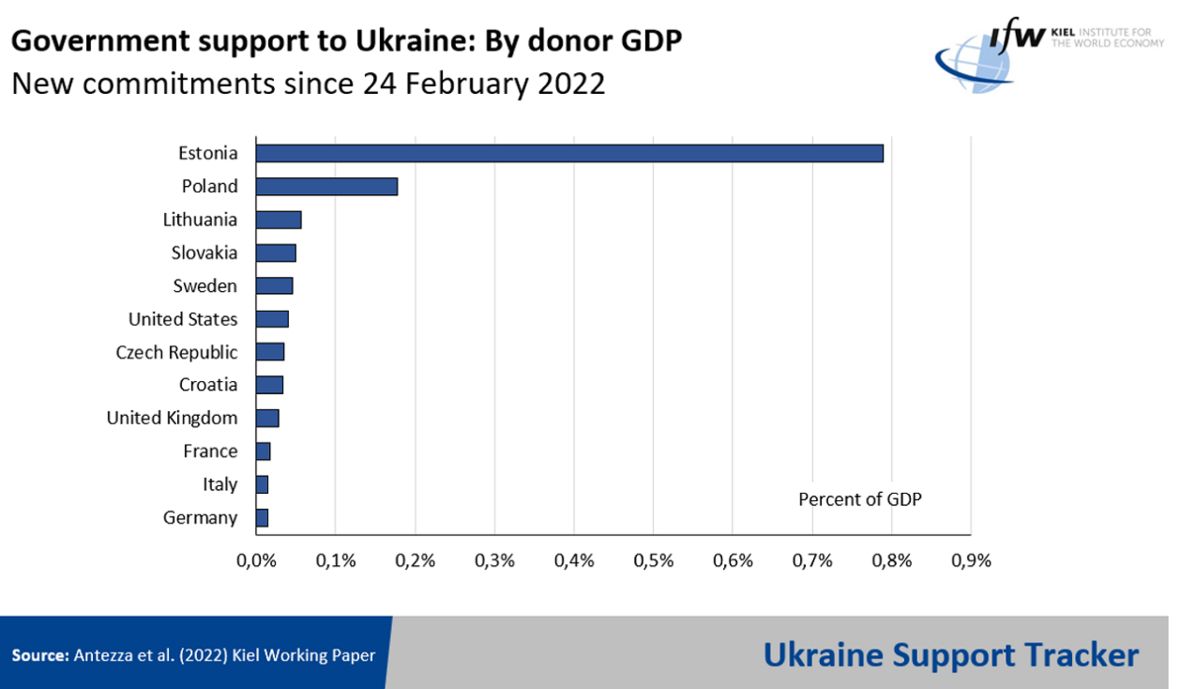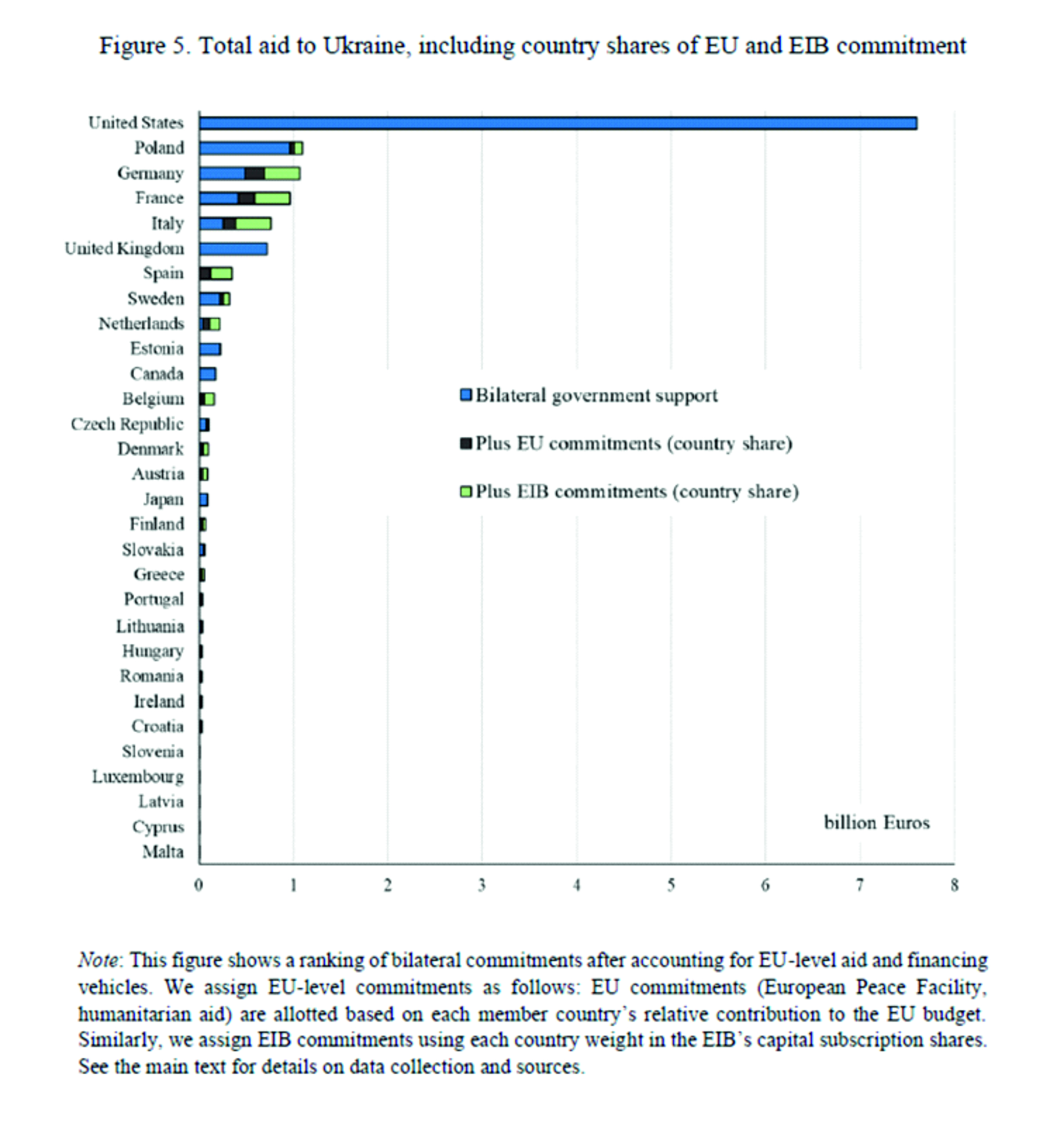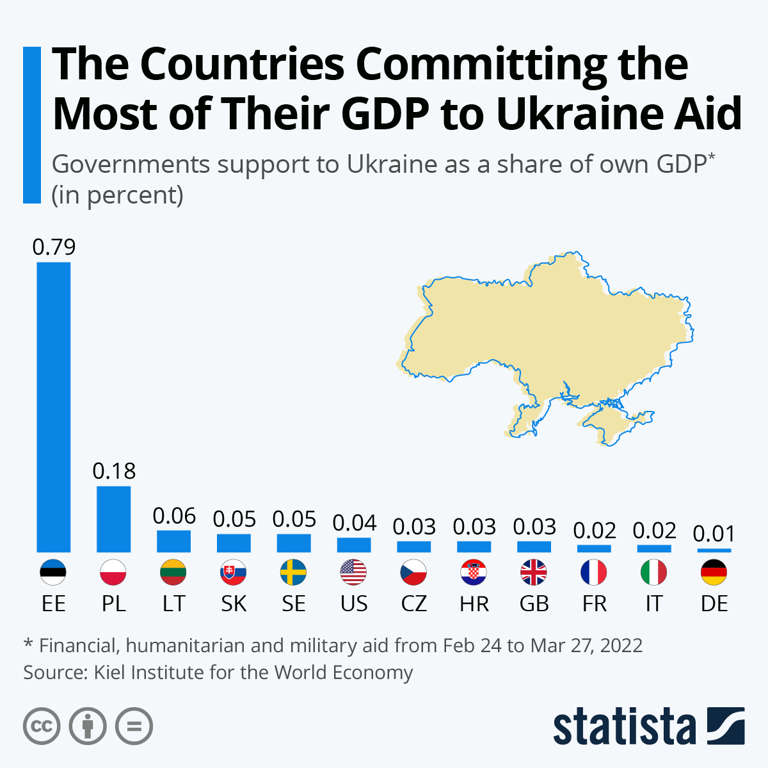A couple of articles worth looking at. First: Where Military Aid to Ukraine Comes From
This was published three hours ago, showing the total aid “pledged” by each country through 27 March. The U.S. certainly leads in that category with 4.77 billion provided. Biden today just added another 800 million in military aid and 500 million in humanitarian aid in addition to 800 billion in military aid promised in mid-April.

Second on the list is Estonia followed by the UK. Most people can’t find Estonia on a map. It is a small country of only 1.3 million people.
This leads us to the next article here from yesterday: Estonia sent Ukraine aid worth 0.8 percent of GDP in first month of war
It is also from the Kiel Institute for the World Economy and only covers through March 27. It tracks aid “pledged” as a percent of GDP. Estonia is by far the largest there with 0.8% of their GDP dedicated to helping Ukraine. Poland is second. The U.S. is in the middle of the pack. At the bottom of the list is Europe’s economic powerhouse, Germany, followed by Italy and France.

For some reason, NATO member Canada is not listed on this chart but are in the chart above. The numbers appear confused. Also, Germany is providing significant aid above and beyond military aid. This will boost the percent of GDP figures higher if that was used as the metric. Figure 5 is shown below from the Kiel Institute report, provided here as a courtesy of one of the followers of our blog: https://www.ifw-kiel.de/fileadmin/Dateiverwaltung/IfW-Publications/-ifw/Kiel_Working_Paper/2022/KWP_2218_Which_countries_help_Ukraine_and_how_/KWP_2218.pdf.

It clearly shows the additional non-lethal aid being provided by Germany, France, Italy, Spain and Belgium. Still, with the aid figures doubled for Germany, France and Italy, it still does not reach the same level of support as provided by the United States as measured by % of GDP. It certainly does match the level of support provided by Estonia (which is on the front line). The figure above also does not pick up the 1.5 billion in non-lethal aid that the U.S. is providing.
In the end, Germany, France, Italy and the UK probably need to up their game a little bit.
Update: Statista provided an updated chart showing financial, humanitarian and military aid as a percent of GDP, which was figures I did not have at the time. Germany, even when all their non-military aid is included, it still at the bottom of the list, followed by Italy and France. Now, this data only goes through 27 March. We do seem to be seeing a slow readjustment by Germany. As there is only one country between them and Ukraine, you would think they would take a little more seriously.
The new chart is here:


Here the link to the KWP full paper:
https://www.ifw-kiel.de/fileadmin/Dateiverwaltung/IfW-Publications/-ifw/Kiel_Working_Paper/2022/KWP_2218_Which_countries_help_Ukraine_and_how_/KWP_2218.pdf
And for some balance you could also use Figure 1 and Figure 5. 🙂
Thanks. Of course, it is versions of figure 4 that are floating around the ether and putting pressure on Germany. I am mystified about the calculations on Canada as the figures I have are showing them providing 0.10 billion in military aid compared to Germany with 0.13 billion. The GDP of Canada is 2.2 trillion, while Germany is 4.3 billion.
I would add figure 5 to my post to provide some balance, except I am unable to copy it as a photo file. I also note that there is not a figure 6 (% GDP).
Why don’t you simly snip it and give a correct source?
I tried, I can’t do that on this computer. I need a picture file (like JPEG) to post it to the blog. I don’t have an IT guy to help me.
I have a JPEG (3.5 MB). Where to send?
Not very useful and very misleading. You’d think from that nonsense that Australia, Japan, Switzerland, NZ and others hadn’t contributed anything.
Ulenspiegel, email to LawrenceTDI@aol.com. Thanks.